
Protection vital for future, locals tell Mabus
August 17, 2010Back-to-school road safety tips for children and parents
August 19, 2010The South Central Safe Community Partnership held a traffic summit last Wednesday in the Cotillion Ballroom at Nicholls State University to discuss enforcement of driving laws and the Strategic Highway Safety Plan (SHSP).
The audience consisted mostly of police officers from around south Louisiana, and the summit offered ways for the officers to become better educated to enforce laws designated to keep drivers safe and alive.
Retired Louisiana state police trooper and former Terrebonne Parish director of public safety Ralph Mitchell Jr. warned the officers in attendance not to have the wrong motive.
“Educate your public on what you are doing and why you are doing it,” Mitchell said when he told the officers to announce speed traps and DWI checkpoints. “Dedicate to public safety and quality of life.”
Louisiana Department of Transportation and Development highway safety manager Terri Monaghan presented the bulk of the details concerning SHSP. The primary goal is to reduce fatalities across the state by 50 percent by 2030.
The 3-year automobile fatality average throughout the state from 2006-08 was 965 per year, and 824 people were killed in automobile accidents in 2009. The goal is to keep the number less than 845 in 2015 and 483 in 2030.
The plan will enlist task forces to focus on speeding, aggressive driving, distracted driving and impaired driving to achieve the goal.
The final two hours of the program focused on teenage drivers and the dangers of texting and driving.
In the Tri-parish area, 8.1 percent (14,134 of 174,129) of the total licensed drivers are between the ages of 15-20. However, the same demographic makes up for 20 percent (498 of 2,485) of crashes resulting in injuries, according to the LSU Highway Safety Research Group.
More crash report data can be found at lhsc.lsu.edu.
Two presenters – Tisa Hill of the Lafourche Parish school district and Mike Page, director of safety and loss prevention at the Louisiana Workers Compensation Corporation in Baton Rouge – argued that using a cell phone while driving impairs a driver’s reaction time as much as the legal alcohol limit of .08.
“I’m not trying to get Baptist – hell, fire and brimstone – on you, but the point has to get it out there,” Page said. “Not just to the kids, but to us. We’re texting and driving too.”
As of this past Sunday, texting and driving is banned in the state for all drivers and is a primary offense. Drivers under the age of 18 are banned from using any wireless device.
Tracy Robert, head nurse of Chabert Medical Center’s emergency department, said they will begin to offer the Sudden Impact Program, which will target ninth grade students and teach them the dangers of distracted driving through a medical, law enforcement and victim perspective.
One of the easiest ways to reduce fatalities on the highways is for people to just strap on their safety belt. In 2009, 54 percent and 39 percent of fatalities were unbelted in Lafourche and Terrebonne, respectively, Jamie Ainsworth said.
Ainsworth, public information officer at the Louisiana Highway Safety Commission, tries to convince people to buckle up through commercials.
One, titled “Faceplant,” is set to run near Thanksgiving. A car is rear-ended in the clip, and the driver vaults headfirst into the windshield. It is too graphic to show on the network channels, but that is the intent, she said.
“We wanted the population to be disturbed,” she said about another seatbelt commercial that elicited a negative response. “The rationale is to target and motivate the population that still refuses wear seatbelts.”









